Excerpts from Jim Conrad's
Naturalist Newsletter
entry from field notes dated January 19, 2023, taken along steep, one-lane gravel road ascending forested, northeast-facing mountain slope, elevation ±2,380m (7600 ft); bedrock of intrusive, igneous granodiorite and diorite; on the south side of Pinal de Amoles, Querétaro state, MÉXICO, (N21.134°, W99.629°)
TERNSTROEMIA SYLVATICA
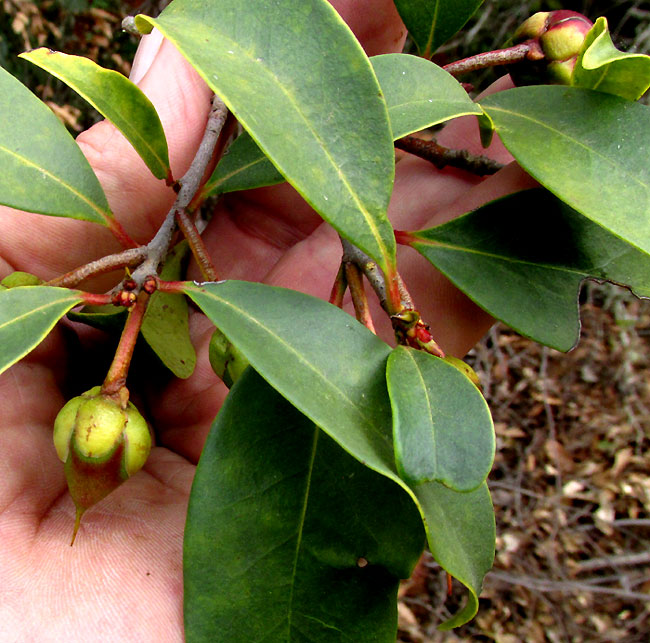
Atop a ridge where clouds must frequently sweep through the forest as cold fog, a small tree much entangled with other small trees and vines bore the above immature fruits. The fruit's form with its stiff, persistent style, the large, thick, rounded sepals, and the simple, thick leaves with hard-to-see secondary veins, and short, thick petioles, reminded me of what can be seen on a camellia shrub. Camellias are members of the Tea Family, the Theaceae, and I remembered years before meeting a Tea Family member in Querétaro's high mountains, as described in the following entry. That bush had been Ternstroemia sylvatica, so maybe this is that. Back then I didn't have a camera capable of close-ups, but now I did, so here's a close-up of an immature fruit with its big sepals:

I wasn't really sure this was a Ternstroemia, so an immature fruit was bitten open, revealing the following:
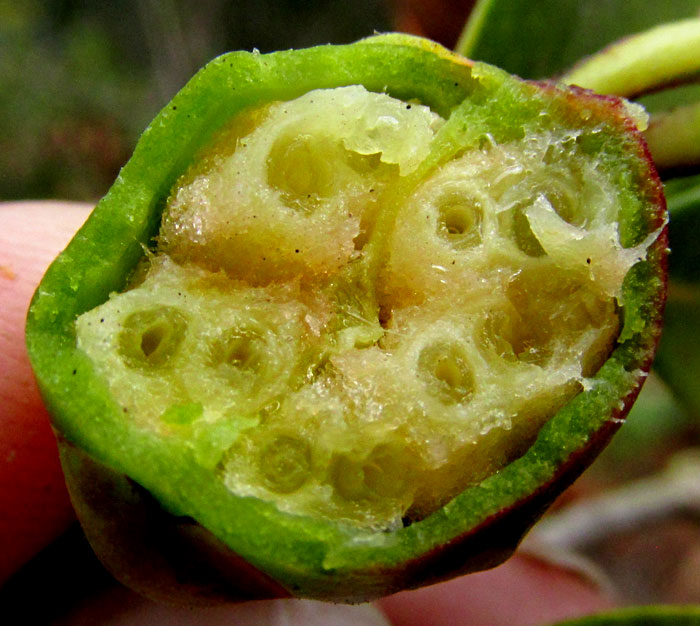
The ovary had two divisions, or locules. Inside each locule five or so seeds were developing, with each immature seed encased in a spongy matrix, presumably the future aril, or fleshy seed-covering. All that fit the Tea Family and Ternstroemia very nicely. Just for the record, here's what the hairless, stipule-less stems and petioles looked like:

Finally, this is what a German visitor looks like taking pictures of the little tree atop its windswept ridge:
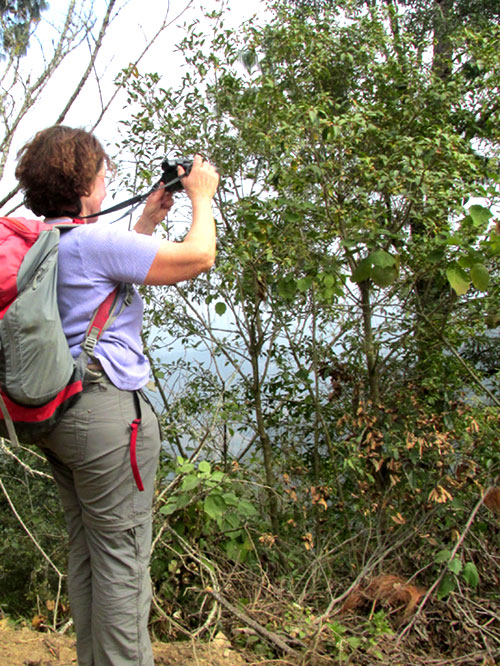
Later that day, a stone's throw downslope, a similar tree with the same kinds of fruits was found. Moreover, this one bore a single flower, shown below nicely showing how the twisting anthers are tipped with a tiny point:
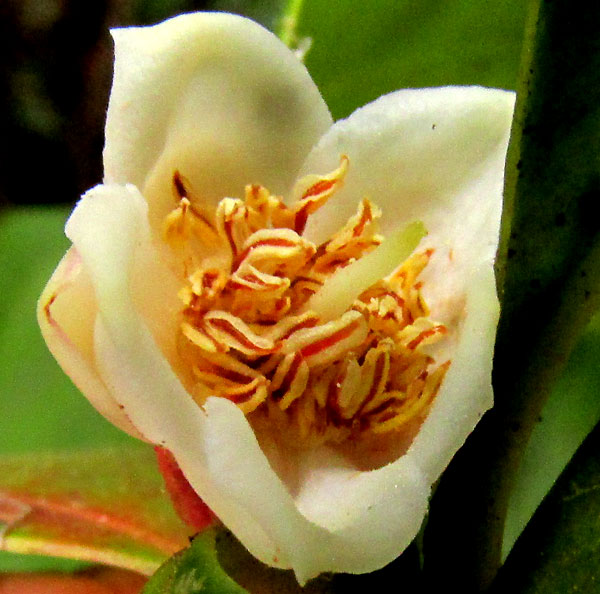
From the side, you can see the blossom's style extending beyond the stamens and petals:
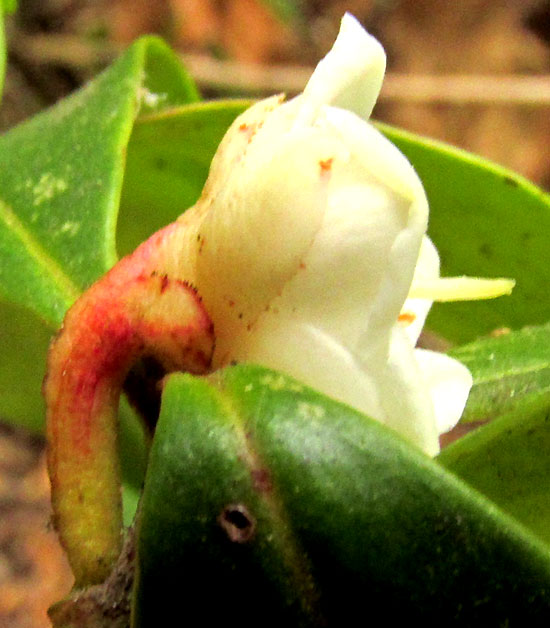
Now it was even clearer that we had Ternstroemia sylvatica, which bear no English name, though in Spanish often it's called trompillo, or "Little Trumpet," apparently for the flowers' shape. The species is distributed in highlands from northeastern and central Mexico south to Belize and El Salvador, in mountain forests at 1200-2700m (3900-8900ft).
The 2022 publication by J. Reyes-Matamoros and others, entitled "Importancia relativa de las especies medicinales ofertadas en el mercado de Tepeaca, Puebla, México," looked at medicinal herbs currently being sold in a traditional market in Tepeaca in the Mexican state of Puebla. The authors found flowers and fruits of Ternstroemia sylvatica being sold for calming the nerves, and dealing with circulatory problems and high blood pressure.
The 2017 study by Claudia V. Moreno-Quirós entitled "Antioxidant, anti-inflammatory and antinociceptive potential of Ternstroemia sylvatica Schltdl. & Cham" came to the conclusion that "Our work confirms the value of Ternstroemia sylvatica as an important anti-inflammatory and analgesic plant, whose mechanism seems to be associated to its antioxidant effects, and supports its uses in the Mexican traditional medicine."
from the July 6, 2007 Newsletter issued from Sierra Gorda Biosphere Reserve, cloudforest at about 6500 feet (2000 m) in elevation, atop one of the main ridges of the Eastern Sierra Madres near the boundary of Querétaro and San Luis Potosí states off Hwy 120, QUERÉTARO, MÉXICO
FRUITING TERNSTROEMIA
Very common on moist, lower valley slopes are large, evergreen shrubs or small trees with thick, dark-green leaves clustered at twig tips, to a Northerner's eyes looking like rhododendrons. However, the fruits -- which these days have just split open -- aren't like rhododendron fruits at all. I think the plants are TERNSTROEMIAS. You can see the unusual fruits below:
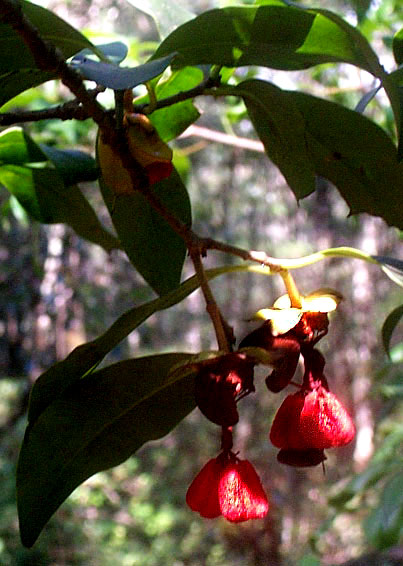
Those fruits need a bit of interpretation. Just right of the center notice the star-shaped, cream-colored item. That's a flower's thickened, persistent calyx. The corolla withered and fell away long ago, and now the narrowly pear-shaped fruit has matured and split open. Upon splitting, a slender column remained in the fruit's center, surrounded by a few large seeds, each covered with a pulpy, red material (the aril). The seeds tumbled from their position but remained dangling from the column, attached by slender threads.
Mantle your seeds with a red, spongy, edible-looking material and set them dangling in free space... It's hard to think of a more effective manner of offering seeds to potential disseminators such as birds.
Three Ternstroemia species are listed for the Reserve but I have no way of knowing which this is. {Eventually identified as Ternstroemia sylvatica}. Ternstroemias are closely related to Camellias and the shrub producing leaves used as tea, the Tea plant. They're members of the Tea Family.